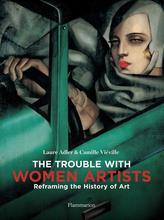More about Hannah Höch
- All
- Info
- Shop

Contributor
I wonder if Hannah Höch really got those guys sandwiches and coffee...
Hannah was born into an upper/middle class family in the south-east of Germany. She attended the Berlin College of Arts and Crafts. Sculpture and painting were deemed as “serious men’s business," while glass design and graphic arts were more suitable for women. After college, Hannah started a turbulent but incredibly creative relationship with Raoul Hausmann. Together with her married boyfriend, she immersed herself in the Dadaist movement. Hannah ended their relationship in 1922, but his name would forever be associated with hers. They were one of those artsy couples where the guy has a big mouth, but the girl is actually getting stuff done in the background.
When the couple took a vacation to the Baltic, they came across this weird photograph, someone had superimposed their hosts face over a stock photo of men in uniform. Hausmann claimed this as his discovery of the photomontage, which would eventually be one of the most important Dada techniques. Hannah, on the other hand, observed that such raw superimposition was something that was frequently done by the German Army. The couple developed the Dadaist photomontage technique in tandem, but their subject matter was very different. Hannah used images from fashion magazines, pasted male heads onto females bodies and the other way around. Hannah celebrated women's emancipation, railed against violence, and parodied the commodification of women with her collages. The Dadaists were pretty reluctant to include women though, let alone women empowerment! Dadaist Hans Richter described Höch's contribution to the Dada movement as the, "Sandwiches, beer and coffee she managed somehow to conjure up despite the shortage of money." Ugh, really?
After the demise of the Berlin Dada movement in 1920 Raoul Hausmann reinvented himself as a “society photographer." Hannah dumped his ass in 1922 and pronounced Hausmann as “boring." Lol. “All he talks about is the things he can now afford to buy," she wrote. After his death, she wrote another classic: “He needed constant encouragement to carry out his ideas and achieve anything at all lasting. If I hadn’t devoted so much of my time to looking after him I might have achieved more myself.” Now where have we heard that one before?!
Meanwhile, Hannah developed herself further as an artist, experimenting with embroidery and taking her collages in a more abstract direction. But with the rise of the Nazis, the atmosphere changed and former Dadaists were blacklisted and watched by the Gestapo. A few years after her break-up with Hausmann, Hannah fell in love with Dutch writer and linguist Mathilde ('Til') Brugman. The two met through mutual friends Dadaist Kurt Schwitters and his wife Helma. In Autumn 1926, the lovebirds moved to the Hague in the Netherlands. They were close friends with the guys from de Stijl, like Piet Mondrian and Gerrit Rietveld. De Stijl artist Vilmos Huszár decorated their “music room” and Rietveld gave them one of his famous monochrome chairs. The pair moved back to Berlin in 1929 and lived together until they broke up in 1935. From 1938 until 1944, Hannah was married to young pianist Kurt Matthies. Get it, girl.
Last but not least, Hannah was seen as the embodiment of something they called “the New Women”. A women who had bobbed hair, who worked, had sex and voted. However, Hannah knew this was just a media creation. Just like how feminism nowadays is still used by the media to promote consumerism. Her “Portrait of Hannah Höch” from 1926 shows her looking like the "New Woman", with short hair and androgynous dress, but unfortunately still far from liberated.
Sources
- http://www.telegraph.co.uk/culture/art/10545071/Hannah-Hoch-The-woman-t…
- http://www.inthein-between.com/hannah-hoch/
- http://www.newstatesman.com/juliet-jacques/2014/01/new-woman-berlins-fe…¶ch
- Lavin, Maud. "The New Woman in Hannah Hoch's Photomontages: Issues of Androgyny, Bisexuality, and Oscillation." in Reclaiming Female Agency: Feminist Art History After Postmodernism, (Berkeley, CA: University of California Press, 2005)
Featured Content
Here is what Wikipedia says about Hannah Höch

Hannah Höch (
German: [hύ]; 1 November 1889 Р31 May 1978) was a German Dada artist. She is best known for her work of the Weimar period, when she was one of the originators of photomontage. Photomontage, or fotomontage, is a type of collage in which the pasted items are actual photographs, or photographic reproductions pulled from the press and other widely produced media.
An important element in Höch's work was the intention to dismantle the fable and dichotomy that existed in the concept of the "New Woman": an energetic, professional, and androgynous woman, who is ready to take her place as man's equal. Her interest in the topic was in how the dichotomy was structured, as well as in who structures social roles.
Other key themes in Höch's works were androgyny, political discourse, and shifting gender roles. These themes all interacted to create a feminist discourse surrounding Höch's works, which encouraged the liberation and agency of women during the Weimar Republic (1919–1933) and continuing through to today.
Check out the full Wikipedia article about Hannah Höch

















